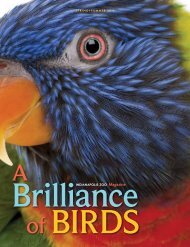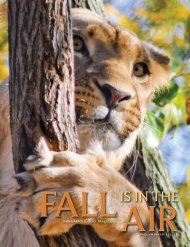IndIanapolIs Zoo annual RepoRt 2011
IndIanapolIs Zoo annual RepoRt 2011
IndIanapolIs Zoo annual RepoRt 2011
Create successful ePaper yourself
Turn your PDF publications into a flip-book with our unique Google optimized e-Paper software.
ReMakInG tHe FutuRe<br />
tHRouGH conseRvatIon<br />
preserving the threatened and endangered animals<br />
of the world is a large and tremendous challenge, but<br />
conservationists like those supported by the Indianapolis<br />
<strong>Zoo</strong> have dedicated their lives to developing strategies<br />
and solutions that ultimately have a positive impact. In<br />
<strong>2011</strong>, your support of the <strong>Zoo</strong> helped these pieces fall<br />
into place for amur tigers in the Russian Far east, as well<br />
as lions, elephants, and cheetahs in africa.<br />
n<br />
n<br />
n<br />
For the Amur tigers that Dr. Linda Kerley and the other<br />
members of the Amur Tiger Conservation Project study in<br />
Lazovsky Preserve in Primorsky Krai, the Indianapolis <strong>Zoo</strong>’s<br />
support paid for 15 vitally important tracking cameras<br />
that give Linda long-distance insight into the lives of the<br />
last few remaining wild Amur tigers on Earth. Camera<br />
traps were also instrumental in establishing a deterrent<br />
program for poachers called “forest eyes” that uses<br />
hidden surveillance cameras to record illegal activity<br />
in protected tiger habitat.<br />
Dr. Bernard Kissui of the African Wildlife Foundation is<br />
saving lions through literally mending fences. Not fences<br />
that keep lions in but fences that protect livestock at night<br />
from being eaten by lions. Lions killed in retaliation for<br />
dead livestock are estimated to account for up to 20<br />
percent of all lion deaths in the area. Small corrals or<br />
“bomas” used by the local Maasai peoples to protect their<br />
livestock at night are traditionally made from thorny<br />
brush or poles, which are no match for lions. Support<br />
provided by the <strong>Zoo</strong> in <strong>2011</strong> helped Kissui build 50<br />
predator-proof bomas using chain-link fencing, providing<br />
more economic security for families and a secure future<br />
for the 170 lions that live in the area.<br />
<strong>2011</strong> marked the fifth year that the <strong>Zoo</strong> has provided<br />
substantial support to Dr. Charles Foley and his amazing<br />
work through the Tarangire Elephant Project to fit<br />
together the puzzle of establishing corridors through<br />
n<br />
rapidly expanding settlement areas so that elephants<br />
and humans can live side by side. Agreements with villages<br />
have resulted in the establishment of corridors through<br />
village lands to allow the elephants to move out of the<br />
Tarangire National Park into calving grounds vital to the<br />
long-term survival of the population. The <strong>Zoo</strong>’s support<br />
pays for the game scouts that track these elephants, as<br />
well as travel and communication with the local villagers<br />
to maintain these easements.<br />
Meanwhile, our Race-a-Cheetah activity at the <strong>Zoo</strong> raised<br />
more than $15,000 for the Cheetah Conservation Fund in<br />
Namibia in <strong>2011</strong>. There is really no other zoo activity like<br />
this in the world, in which the tie between the activity<br />
itself (testing your speed against that of the cheetah)<br />
and contributing to saving the animals in the wild is<br />
so entwined. In the two years since we began Race-a-<br />
Cheetah, more than 60,000 young <strong>Zoo</strong> visitors have<br />
participated, and their contributions––gathered 50 cents<br />
at a time––add up to a total of almost $30,000 since 2010.<br />
Their donations in <strong>2011</strong> paid for the care of two orphaned<br />
cheetahs for a year, two litters of livestock-guarding<br />
Kangal puppies, and the medical workup and release<br />
of three wild cheetahs.<br />
closeR to HoMe<br />
luGaR eneRGy patRIot aWaRd<br />
In <strong>2011</strong>, the Indianapolis <strong>Zoo</strong> was named a Lugar Energy<br />
Patriot, an honor bestowed on organizations that support<br />
renewable energy sources and energy conservation, by<br />
Indiana Senator Richard Lugar. We earned this prestigious<br />
citation through a whole host of green practices that<br />
support the concept of sustainability in our operations.<br />
15




